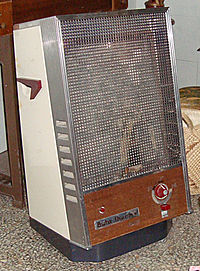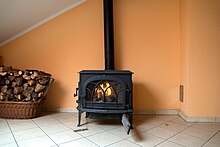Kerosene heater


A gas heater is a heater used to heat a room or outside area by burning natural gas, liquefied petroleum gas, propane, or butane.
Operation
A gas heater controls its cycle by using a mechanical or electronic thermostat. Gas flow is turned on with a valve. The gas is lit by an electric filament or pilot light. Flames heat a radiator in the air duct, convection or a fan may distribute the heat to the room.
Non-flued heaters

Non-flued heaters – also known as unvented heaters, vent-free heaters, or flueless fires, are either permanently installed or can be moved around, and sometimes will have a catalytic converter. [1] Non-flued heaters can be not safe if safety rules are not followed. There must be enough ventilation and they must be kept clean. They should always be switched off before sleeping. If they are operating correctly then the main emissions of a non-flued gas heater are water vapor, carbon dioxide, and nitrogen dioxide.
Flued heaters

Flued heaters are permanently installed wherever they are placed. The flue, if properly installed correctly should remove all of the heater emissions. A correctly operating flued gas heater is safe for use.
Not all flued heaters are allowed for use in indoor living spaces. Some flued gas heaters can be used indoors, but not where people eat or sleep. For example, the normal power-vented garage unit heater in North America. These heaters are best in garages, commercial areas, or industrial spaces. They are not good where people live.[2]
References
- ↑ "RR023 - Flueless gas fires - concentration of carbon monoxid..." www.hse.gov.uk.
- ↑ BPH Mechanical Sales Ltd. "Unit Heaters 101 - An Intro to Garage, Workshop, and Greenhouse Heating". BPH Sales. Retrieved 22 May 2023.